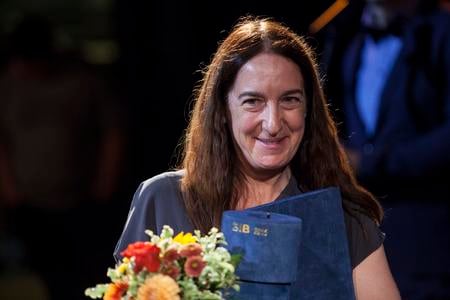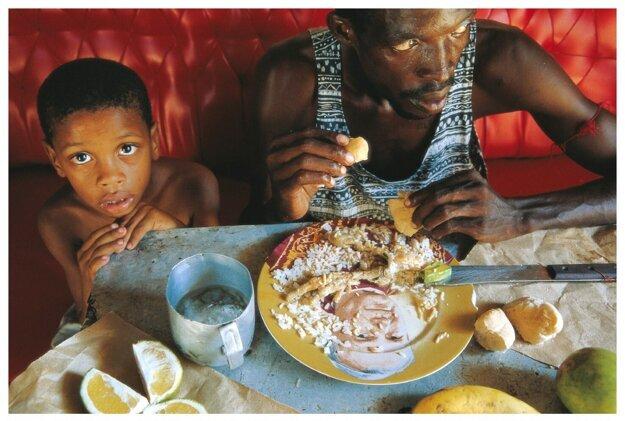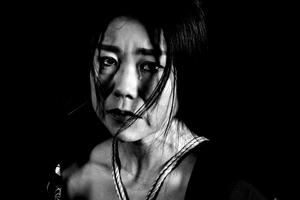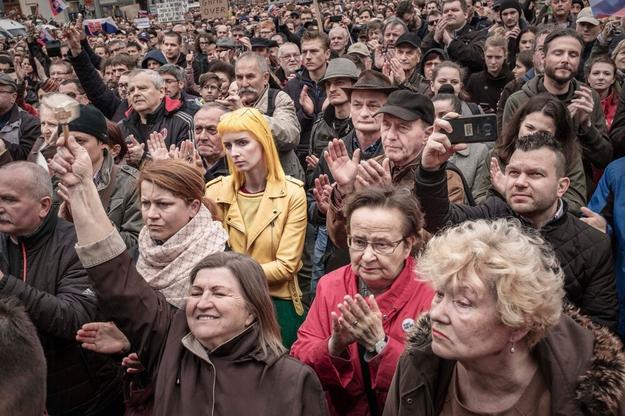"He comes and goes. But what remains after him? At least one souvenir." With a photo, Austrian Lois Lammerhuber answers a question that hangs quietly in the air in every country after a papal visit.
In the photo, a young man finishes eating rice from a plate with a portrait of Pope John Paul II. It comes from Lammerhuber's Latin American trilogy, which is the result of his fifteen-month stay in the countries of South America. In the first part he mapped the visit of Pope John Paul II in the Dominican Republic, when his face was everywhere, on balloons, forks, and buttons.In the photo, a young man finishes eating rice from a plate with a portrait of Pope John Paul II. It comes from Lammerhuber's Latin American trilogy, which is the result of his fifteen-month stay in the countries of South America. In the first part he mapped the visit of Pope John Paul II in the Dominican Republic, when his face was everywhere, on balloons, forks, and buttons.
The collective exhibition Viva Latina!, which is one of the top displays during this year's Month of Photography, also lets people explore other forms and problems of Latin America through photography.
Organisers hope that the 31st edition of the festival will be much better than last year, when the pandemic prevented them putting together a rich event. During November, visitors can look forward to seeing up to 23 individual and collective exhibitions and experience a number of accompanying events.
Festival director Václav Macek says this year the Month of Photography is not very traditional since the pandemic is still affecting it. Thanks to the relatively high vaccination rate of the residents of Bratislava, all exhibitions are open, but only to the vaccinated, the tested and those who have recovered from Covid.
The festival is again divided into several blocks. World Photography offers the large collective exhibition Viva Latina! in Zoya Gallery. The Central European Photography block surprises visitors with an extensive collection of works by a creative couple from Bulgaria, and Slovak works are also on display within this section.
The program also includes three open-air exhibitions in Bratislava: The Golden 60s on the wall of the gallery Umelka, Viva Latina! 2 on Michalská Street and The Alley of Photography on Prepoštská Street.
Tears and sweat of Latin America
"The first time I saw the Serra Pelada Mine, I was unable to speak. In front of me lay a huge pit nearly 200 metres wide and just as deep, teeming with tens of thousands of poorly dressed men. Half of them carried heavy sacks of soil up the rickety wooden ladders, the other half rushed down the muddy slopes into the abyss. They were looking for gold."
This is how Brazilian photographer Sebastiao Salgado begins his story about a series of photographs from the now defunct gold mine Serra Pelada in Brazil.
He photographed them in 1986, when he was 44, but the public has been able to admire their beauty only since 2016. Salgado injured his knee and finally had time to edit his photos.
Serra Pelada in Salgado's black-and-white photos is reminiscent of Boticcelli's painting Hell with cascading muddy sidewalks, steep ladders and thousands of squatting men dressed in rags that used to be T-shirts. Their faces are tired from fatigue, their eyes blank.
Salgado lived with the miners for 35 days and took pictures without a break, even when they fell from narrow ladders or crossed over dead colleagues.
His photographs are among the most powerful images of Viva Latina!, which brings together the work of nine authors who respond to the biggest problems of the Latin American continent such as fires in the Amazon rainforest, extensive wood logging, political chaos and great social disparities.
Argentinian Marcos López uses self-irony to portray these problems. Influenced by Warhol and Diego Rivera, he also finds inspiration in commercial advertising. It is this blend that made him a leading figure in Latino Pop style.

Viva Latina! also presents one of his most famous photographs, The Last Supper. The author and his friends sit at a long table, as do Jesus and the 12 apostles in Da Vinci's painting, and gorge on food.
The irony lies within the painting's name. López took the picture of this composition a few months before the outbreak of the financial crisis in Argentina in December 2001. Most Argentinians really had their last proper dinner at the time.
Another important theme of the Viva Latina! exhibition is environmental protection. In Brazil, after the election of Jair Bolsonaro as the country’s president in 2018, the rate of deforestation doubled in one year.
In 2019, on the front pages of newspapers around the world, images of the great fire of the Amazon rainforest appeared. Carolina Arantes spent several weeks at the epicentre of the fire to document farmers' despair over the lost pasture, as well as the charred landscape previously covered by living forests.
Selection of exhibitions from the World Photography section:
Viva Latina! (Zoya Gallery)
Yolanda Andrade (Dom umenia)
Maxime Ballesteross (Dom umenia)
Isabel Muñoz (Central European House of Photography)
In her Divine Honey series, Nadia Shira Cohen captures the Mayan community on the Yucatán Peninsula. They keep bees of the rare genus Melipona, whose honey is one of the best and most expensive in the world. However, they cannot compete with the subsidised and expanding cultivation of genetically modified crops, so her images will be only a memory of the once famous divine honey.
There are three more prominent names in the World Photography block of the Month of Photography festival. With a great retrospective titled México Mi Amor, Yolanda Andrade breaks down stereotypes about her home country. It captures the reality of everyday Mexicans in celebrations, demonstrations and holidays. The most famous - the Feast of the Dead - comes to life in her black-and-white photographs.
"Jean Cocteau, a French film director, said photography was the only way to beat mortality. Yolanda Andrade's photographs capture a fragment of time that remains as a motionless picture of memory, memory without the past and the future," said Eva Marlene Hodek, curator of the exhibition.
After last year's cancelled exhibition, the Spanish photographer Isabel Muñoz finally visited Bratislava with her Japanese series 1001. She captures butoh dancers, the art of tying people with ropes – shibari – and the slightly disturbing nudes of tattooed yakuza members. At first glance, this is a clear statement, but with Isabel Muñoz, the real truth is always in the details.
Photographs by French artist Maxime Ballesteros may also be controversial. The series is called Entre chien et loup, between a wolf and a dog, and it reminds us that the truth in front of our eyes may not be clear. Erotic poses and playful voyeurism border on soft porn and fetish. Ballesteros tells visitors that everything is welcome and fun at the same time.
Communist cars and a pandemic
A large space in the dramaturgical line representing the work of photographers from Central and Eastern Europe was given to a pair of Bulgarian artists, Boris Missirkov and Georgi Bogdanov.
The internationally renowned cinematographers, film directors, screenwriters, visual artists and, last but not least, photographers have several award-winning visual campaigns, feature-length documentaries and short videos in their portfolio.
Selection of exhibitions from the Central and Eastern Europe section:
Opava Girls (Open Gallery)
Aerobic (University Library in Bratislava)
Through the Eyes of Twelve Polish Women (Polish Institute)
In the Footsteps of the Ancient Past (Pisztory Palace)
For years, they collected stories and archival footage of communist-era cars. Some of them made it into the feature documentary Cars, which people used to drive to capitalism. Others were included in the multimedia exhibition In the Footsteps of the Ancient Past, which includes a parody of the Russian phenomenon - staged selfies, portraits and pictures with communist cars published on Russian social networks. The creative couple from Bulgaria mix nostalgia with a bit of humour.
The theme of socialism lives on in the photographs of Czech Petr Zatloukal. In the 1980s, he created a voyeur probe into the life of women who started to exercise. The photographs show group rhythmic exercises, a Czechoslovak form of aerobics, in old gyms or on large concrete surfaces of dilapidated sports grounds. More than a slender figure, the women were taking a moment for themselves.
A group of students and graduates of the Institute of Creative Photography of the University of Silesia in Opava, the Czech Republic, present themselves with a collective exhibition. They deal with topics such as LGBT relationships and the devastated environment, but also the topic of life during the pandemic.
Poland is represented by 12 contemporary Polish authors of documentary, landscape and creative photography.
Paradoxes of the present and the golden 60s
In the gallery Médium, Slovak photojournalist of a political weekly Boris Németh has opened the exhibition Paradoxes of Photographic Pictures by Boris Németh, which is also a publication of the same name. The series of photographs offers the essence of his view of contemporary Slovakia.
Alan Hyža presents photos from trips to the Spiš region, taken with a wooden camera, in the gallery Artotéka.
The Golden 60s exhibition provides a look into the past, bringing Bratislava from the 1960s comes to life on ten boards. The curatorial selection of photographs by famous names such as Peter Procházka, Karol Kállay, Igor Grossmann, Bohumil Puskailer and others represents a city that no longer exists in the same form today. The lost Vydrica neighbourhood and the portraits of young artists Milan Lasica, Július Satinský and Marián Varga are displayed on the wall of the gallery Umelka until the end of November.
The Latent Revolutions exhibition has brought together three photographers, Milota Havránková, Libuše Jarcovjáková and Zuzana Pustaiová. Each of the authors works in her own time. For Havránková it is the 60s, Jarcovjáková exists artistically in the 80s and Pustaiová depicts the post-revolutionary present. The link is self-realisation and the fight against stereotypes that women constantly face in society, regardless of the period. The exhibition is realised as a pilot project of the newly established Milota Havránková Foundation.
Information about the festival, as well as a list of all exhibitions and planned accompanying events can be found on the website of the Central European House of Photography.
© Sme
Author: Radoslava Baňovič Morongová


 Ameena and Flowers by Maxime Ballesteros. (source: SEDF/Month of Photography)
Ameena and Flowers by Maxime Ballesteros. (source: SEDF/Month of Photography)
 Latin American trilogy by Lois Lammerhuber. (source: SEDF/Month of Photography)
Latin American trilogy by Lois Lammerhuber. (source: SEDF/Month of Photography)



 'Untitled' from the series 'Two, Three, Four' by Isabel Muñoz. (source: SEDF)
'Untitled' from the series 'Two, Three, Four' by Isabel Muñoz. (source: SEDF)
 The 2018 For a Decent Slovakia protest by Boris Németh. (source: SEDF)
The 2018 For a Decent Slovakia protest by Boris Németh. (source: SEDF)